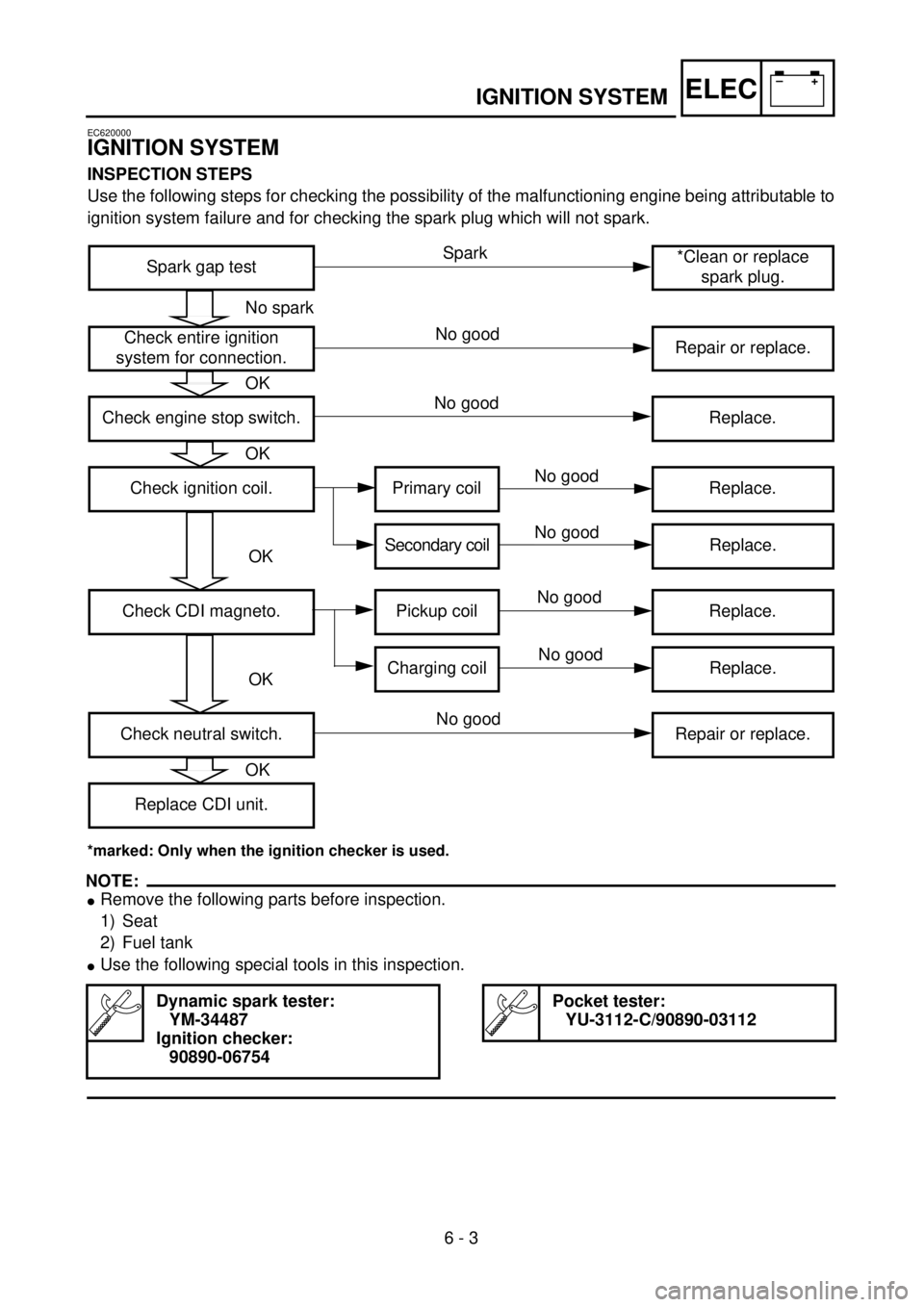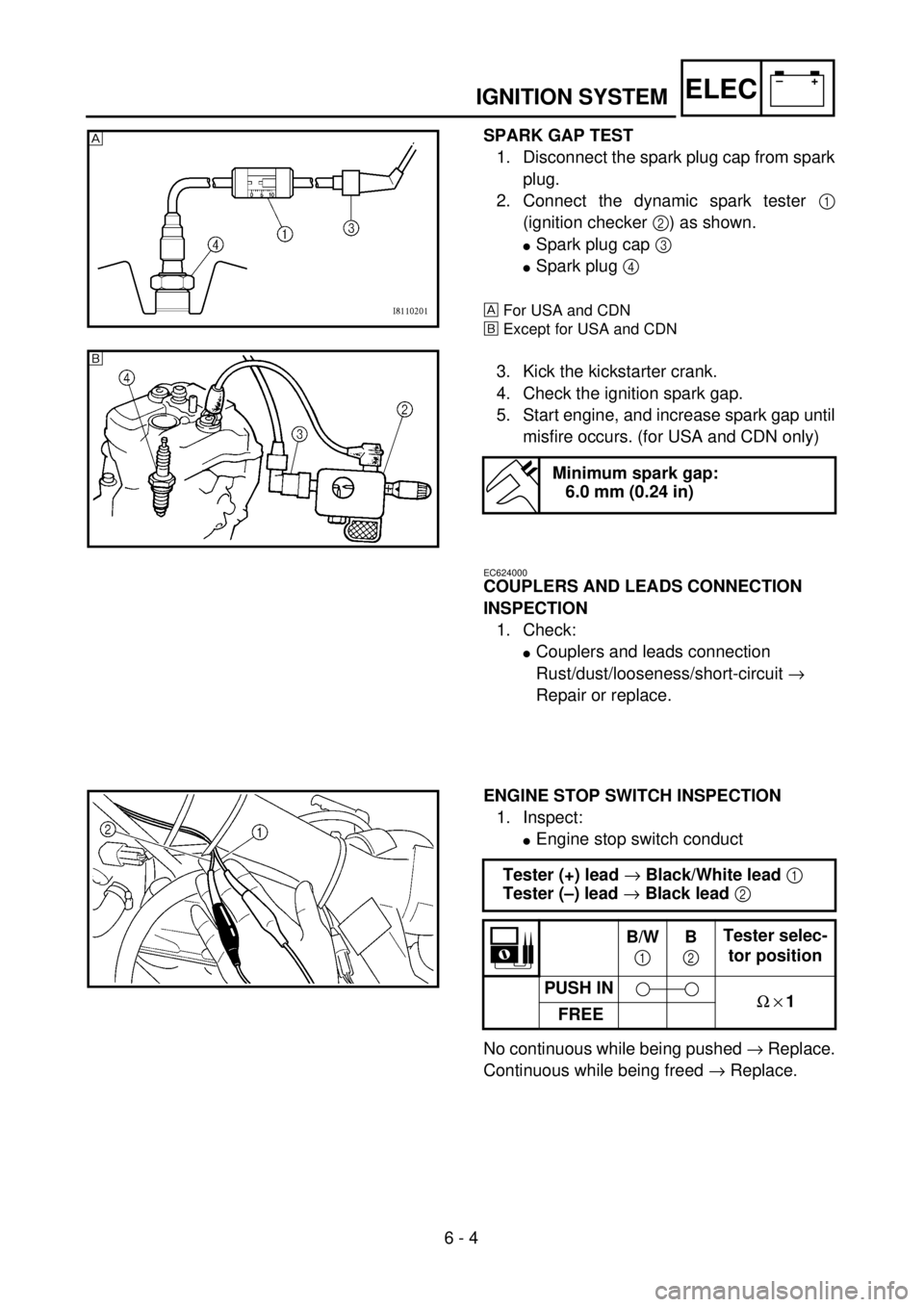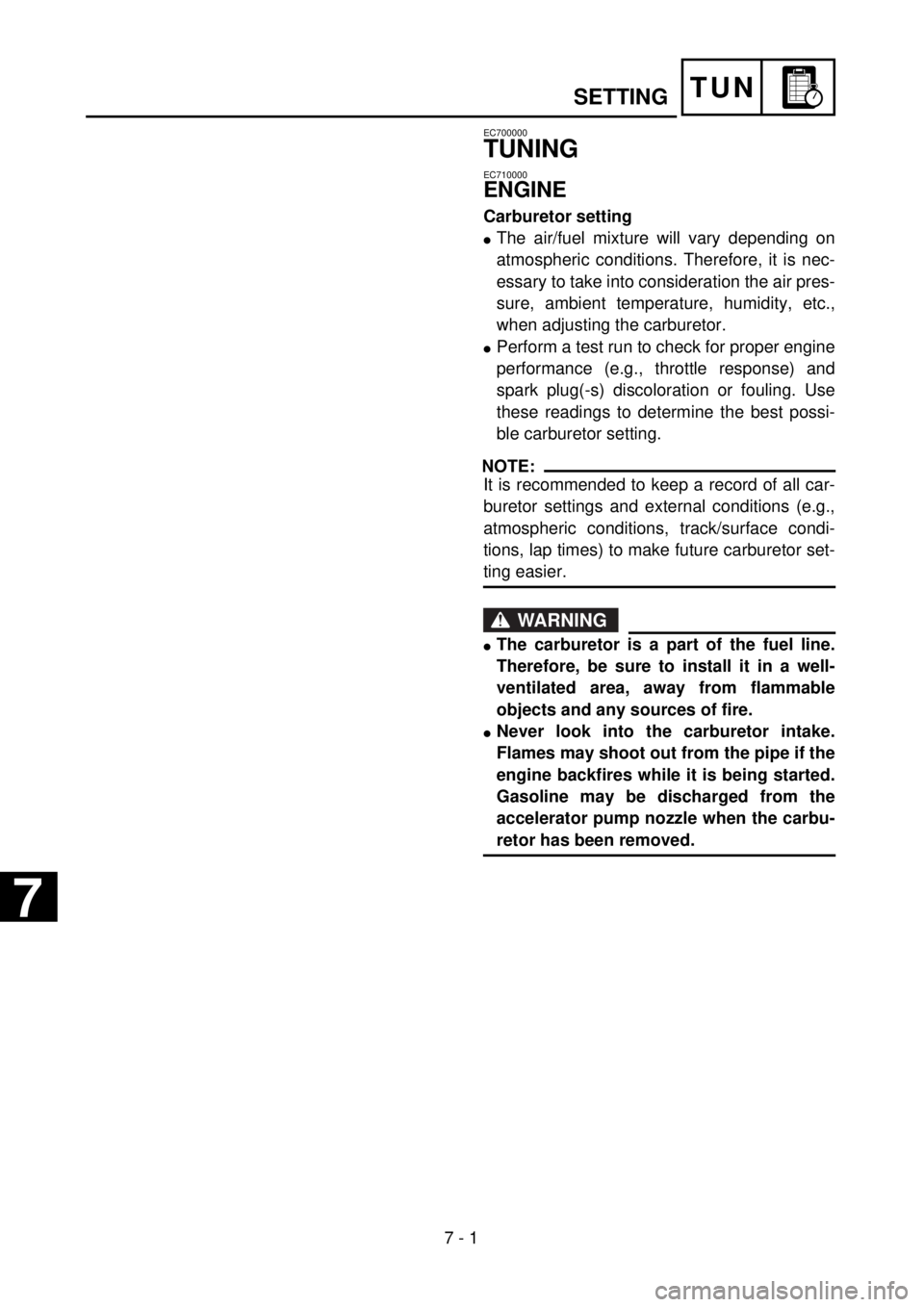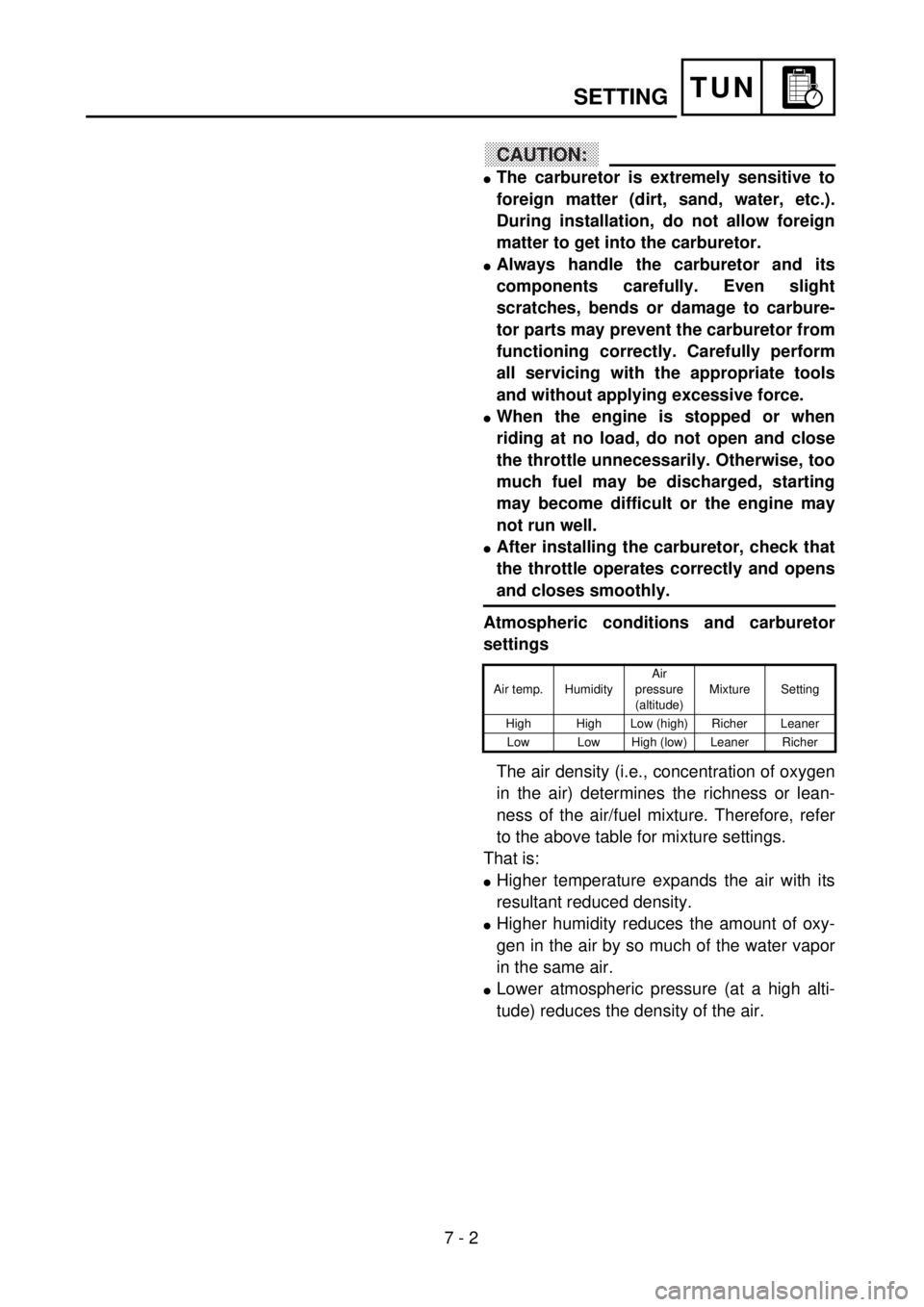engine YAMAHA WR 250F 2001 Notices Demploi (in French)
[x] Cancel search | Manufacturer: YAMAHA, Model Year: 2001, Model line: WR 250F, Model: YAMAHA WR 250F 2001Pages: 686, PDF Size: 62.6 MB
Page 604 of 686

–+ELEC
6 - 2
MAP-CONTROLLED CDI UNIT
MAP-CONTROLLED CDI UNIT
A map-controlled, CDI ignition system is used in the WR250F.
The microcomputer in the CDI unit detects the engine speed and throttle position, thus determining
the optimum ignition timing through the entire operating range. In this way, quick throttle response
can be achieved according to various riding conditions.
CDI unit
Throttle position sensor
Pickup coil CDI magneto rotorIgnition coil
n
Function of Component
Component Function
Throttle position sensor Detects throttle valve opening and inputs it into the computer in the
CDI unit as a throttle opening signal.
Pickup coil Detects signal rotor revolutions and inputs them into the computer in
the CDI unit as engine revolution signals.
CDI unit The signals of the throttle position sensor and pickup coil sensor are
analyzed by the computer in the CDI unit, which then adjusts ignition
timing for the operation requirements.
n
Principal of 3-Dimensional Control
Conventionally, ignition timing was controlled only
by engine revolutions (2-dimensional control).
However, ignition timing needs advancement also
by engine load. Thus, accurate ignition timing can
be determined by adding throttle opening to deter-
mine ignition timing (3-dimensional control).
3-D Image Map of Ignition Timing
(different from actual characteristics)
Revolutions
Ignition timing
Throttle opening
Page 608 of 686

–+ELEC
6 - 3
IGNITION SYSTEM
EC620000
IGNITION SYSTEM
INSPECTION STEPS
Use the following steps for checking the possibility of the malfunctioning engine being attributable to
ignition system failure and for checking the spark plug which will not spark.
*marked: Only when the ignition checker is used.
NOTE:
l
Remove the following parts before inspection.
1) Seat
2) Fuel tank
l
Use the following special tools in this inspection.
Dynamic spark tester:
YM-34487
Ignition checker:
90890-06754
Pocket tester:
YU-3112-C/90890-03112
Spark gap test*Clean or replace
spark plug.
Check entire ignition
system for connection.Repair or replace.
Check engine stop switch. Replace.
Check ignition coil. Primary coil Replace.
Secondary coil Replace.
Check CDI magneto. Pickup coil Replace.
Charging coil Replace.
Check neutral switch. Repair or replace.
Replace CDI unit.
No spark
OK
OK
OK
OK
OK
Spark
No good
No good
No good
No good
No good
No good
No good
Page 612 of 686

6 - 4
–+ELEC
IGNITION SYSTEM
SPARK GAP TEST
1. Disconnect the spark plug cap from spark
plug.
2. Connect the dynamic spark tester
1
(ignition checker
2
) as shown.
l
Spark plug cap
3
l
Spark plug
4
For USA and CDN
õ
Except for USA and CDN
3. Kick the kickstarter crank.
4. Check the ignition spark gap.
5. Start engine, and increase spark gap until
misfire occurs. (for USA and CDN only)
Minimum spark gap:
6.0 mm (0.24 in)
õ
EC624000
COUPLERS AND LEADS CONNECTION
INSPECTION
1. Check:
l
Couplers and leads connection
Rust/dust/looseness/short-circuit
®
Repair or replace.
ENGINE STOP SWITCH INSPECTION
1. Inspect:
l
Engine stop switch conduct
No continuous while being pushed
®
Replace.
Continuous while being freed
®
Replace.
Tester (+) lead
®
Black/White lead
1
Tester (–) lead
®
Black lead
2
B/W
1
B
2
Tester selec-
tor position
PUSH IN
W
´
1
FREE
Page 618 of 686

–+ELEC
6 - 7
THROTTLE POSITION SENSOR SYSTEM
THROTTLE POSITION SENSOR SYSTEM
INSPECTION STEPS
If the throttle position sensor will not operate, use the following inspection steps.
*marked: Refer to “IGNITION SYSTEM” section.
NOTE:
lRemove the following parts before inspection.
1) Seat
2) Fuel tank
lUse the following special tools in this inspection.
Pocket tester:
YU-3112-C/90890-03112Inductive tachometer:
YU-08036-B
Engine tachometer:
90890-03113
Check entire ignition
system for connection.Repair or replace.
Check throttle position
sensor.Throttle posi-
tion sensor coilReplace.
*Check CDI magneto. Charging coil Replace.
Check CDI unit.Throttle posi-
tion sensor
input voltageReplace.
OK
OK
OK
No good
No good
No good
No good
Page 624 of 686

6 - 9
–+ELECTHROTTLE POSITION SENSOR SYSTEM
THROTTLE POSITION SENSOR
REPLACEMENT AND ADJUSTMENT
1. Remove:
lThrottle position sensor coupler
lScrew (throttle position sensor) 1
lWasher 2
lThrottle position sensor 3
NOTE:
Loosen the screws (throttle position sensor)
using the T20 bit (tamper resistant fastener
type).
2. Replace:
lThrottle position sensor
3. Install:
lThrottle position sensor 1
lWasher 2
lScrew (throttle position sensor) 3
NOTE:
lAlign the slot a in the throttle position sen-
sor with the projection b on the carburetor.
lTemporarily tighten the screws (throttle posi-
tion sensor).
4. Adjust:
lEngine idling speed
Refer to “ENGINE IDLE SPEED
ADJUSTMENT” section in the CHAP-
TER 3.
5. Calculate:
lThrottle position sensor coil resistance
at idle speed
If the throttle position sensor coil resistance is
5 kW, then the throttle position sensor coil
resistance at idle speed is:
5 kW ´ (0.13 ~ 0.15) = 650 ~ 750 W
Refer to “THROTTLE POSITION SEN-
SOR COIL INSPECTION” section
about the throttle position sensor coil
resistance. Throttle position sensor coil resistance
at idle speed:
Throttle position sensor coil resis-
tance ´ (0.13 ~ 0.15)
Page 626 of 686

6 - 10
–+ELECTHROTTLE POSITION SENSOR SYSTEM
6. Adjust:
lThrottle position sensor coil resistance
at idle speed
Adjustment steps:
Adjust the angle of the throttle position sen-
sor 1 to obtain the resistance calculated
(example: 650 ~ 750 W)
Tester (+) lead ® Yellow lead 2
Tester (–) lead ® Black lead 3
7. Tighten:
lScrew (throttle position sensor) 1
NOTE:
Tighten the screws (throttle position sensor)
using the T20 bit (tamper resistant fastener
type).
8. Install:
lThrottle position sensor coupler
THROTTLE POSITION SENSOR INPUT
VOLTAGE INSPECTION
1. Disconnect the throttle position sensor
coupler.
2. Start the engine.
3. Inspect:
lThrottle position sensor input voltage
Out of specification ® Replace the CDI
unit.
Tester (+) lead ® Blue lead 1
Tester (–) lead ® Black/Blue lead 2
Throttle posi-
tion sensor
input voltageTester selector
position
4 ~ 6 V DCV-20
Page 628 of 686

–+ELEC
6 - 11
LIGHTING SYSTEM
LIGHTING SYSTEM
INSPECTION STEPS
Refer to the following flow chart when inspecting the ignition system for possible problems.
NOTE:
lReplace the bulb and/or bulb socket.
1) Seat
2) Fuel tank
lUse the following special tool.
Check the bulb and bulb
socket.Replace the bulb and/
or bulb socket.
Check the light switch. Replace.
Check the CDI magneto. Lighting coil Replace.
Check the entire lighting sys-
tem proper for connections.Repair or replace.
Check the voltage regula-
tor.Out-put volt-
ageReplace.
Pocket tester:
YU-3112-C/90890-03112Inductive tachometer:
YU-08036-B
Engine tachometer:
90890-03113
OK
OK
OK
OK
No good
No good
Improperly connected
No good
No good
Page 632 of 686

6 - 12
–+ELECLIGHTING SYSTEM
LIGHT SWITCH INSPECTION
1. Inspect:
lLight switch continuity
No continuous while being ® Replace.
Continuous while being OFF ® Replace. Tester (+) lead ® Yellow lead 1
Tester (–) lead ® Blue lead 2
Y
1L
2Tester selec-
tor position
W ´ 1
OFF
CDI MAGNETO INSPECTION
1. Inspect:
lLighting coil resistance
Out of specification ® Replace.
VOLTAGE REGULATOR INSPECTION
1. Start the engine.
2. Turn on the headlight and taillight by turn-
ing on the light switch.
3. Inspect:
lOut-put voltage
Out of specification ® Replace voltage
regulator. Tester (+) lead ® Yellow lead 1
Tester (–) lead ® Black lead 2
Lighting coil
resistanceTester selector
position
0.16 ~ 0.24 W at
20 ˚C (68 ˚F)W ´ 1
Tester (+) lead ® Blue lead 1
Tester (–) lead ® Black lead 2
Out-put voltageTester selector
position
13.3 ~ 14.3 V at
5,000 r/minACV-20
BL
1
2
1
2
Page 634 of 686

7 - 1
TUN
EC700000
TUNING
EC710000
ENGINE
Carburetor setting
l
The air/fuel mixture will vary depending on
atmospheric conditions. Therefore, it is nec-
essary to take into consideration the air pres-
sure, ambient temperature, humidity, etc.,
when adjusting the carburetor.
l
Perform a test run to check for proper engine
performance (e.g., throttle response) and
spark plug(-s) discoloration or fouling. Use
these readings to determine the best possi-
ble carburetor setting.
NOTE:
It is recommended to keep a record of all car-
buretor settings and external conditions (e.g.,
atmospheric conditions, track/surface condi-
tions, lap times) to make future carburetor set-
ting easier.
WARNING
l
The carburetor is a part of the fuel line.
Therefore, be sure to install it in a well-
ventilated area, away from flammable
objects and any sources of fire.
l
Never look into the carburetor intake.
Flames may shoot out from the pipe if the
engine backfires while it is being started.
Gasoline may be discharged from the
accelerator pump nozzle when the carbu-
retor has been removed.
SETTING
7
Page 636 of 686

7 - 2
TUN
CAUTION:
l
The carburetor is extremely sensitive to
foreign matter (dirt, sand, water, etc.).
During installation, do not allow foreign
matter to get into the carburetor.
l
Always handle the carburetor and its
components carefully. Even slight
scratches, bends or damage to carbure-
tor parts may prevent the carburetor from
functioning correctly. Carefully perform
all servicing with the appropriate tools
and without applying excessive force.
l
When the engine is stopped or when
riding at no load, do not open and close
the throttle unnecessarily. Otherwise, too
much fuel may be discharged, starting
may become difficult or the engine may
not run well.
l
After installing the carburetor, check that
the throttle operates correctly and opens
and closes smoothly.
Atmospheric conditions and carburetor
settings
The air density (i.e., concentration of oxygen
in the air) determines the richness or lean-
ness of the air/fuel mixture. Therefore, refer
to the above table for mixture settings.
That is:
l
Higher temperature expands the air with its
resultant reduced density.
l
Higher humidity reduces the amount of oxy-
gen in the air by so much of the water vapor
in the same air.
l
Lower atmospheric pressure (at a high alti-
tude) reduces the density of the air.
Air temp. HumidityAir
pressure
(altitude)Mixture Setting
High High Low (high) Richer Leaner
Low Low High (low) Leaner Richer
SETTING